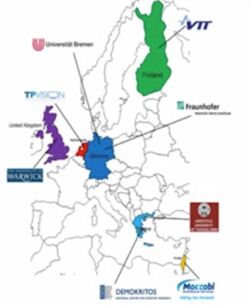Unobtrusive Smart Environments for Monitoring in Everyday Life
| Project Infobox | |
|---|---|
| Self researcher(s) | Homer Papadopoulos |
| Related tools | slae-tablet, web tv, camera |
| Related topics | Social life and social media, Activity tracking, Social interactions, Mood and emotion |
Builds on project(s) |
|
| Has inspired | Projects (0) |
| Show and Tell Talk Infobox | |
|---|---|
| Featured image | 
|
| Date | 2013/05/11 |
| Event name | 2013 QS Europe Conference |
| Slides | |
| This content was automatically imported. See here how to improve it if any information is missing or out outdated. |
Unobtrusive Smart Environments for Monitoring in Everyday Life is a Show & Tell talk by Homer Papadopoulos that has been imported from the Quantified Self Show & Tell library.The talk was given on 2013/05/11 and is about Social life and social media, Activity tracking, Social interactions, and Mood and emotion.
Description[edit | edit source]
A description of this project as introduced by Quantified Self follows:
Papadopoulos Homer, representing the Usefil project explains the QS ecoystem. The QS ecosystems contains monitoring devices, health, and fitness apps and of course rely on very fast networks.
Video and transcript[edit | edit source]
A transcript of this talk is below:
Papadopoulos Homer Unobtrusive Smart Environments for Monitoring in Everyday Life
Hello everyone. Thanks for being here. I’m Papadopoulos Homer and I’m representing the Usefil project. And within the next five minutes I will explain why we’re here, what we’re doing and what we’re looking from you. The QS ecosystem as I will explain contain monitoring devices, health and fitness and many many apps and of course speed; very fast networks. So the next question is how this ecosystem can increase adoption. In order to increase adoption you have to have a product, you have to sell. And in order to sell you have to find customers and of course ou have to identify the needs of the customers. The main area of the ecosystem now is fitness and medical diagnosis. Regarding the fitness we have some problems, regarding the lifestyle it’s very difficult to change behavioral. And regarding the medical diagnosis we also have problems regarding and concerning regulation issues. Let’s see some facts’ we have popular services and we have popular fitness apps and you can see we are talking about mediums and there concerns millions compared to billions. So the main question is how can we go from millions to billions. In order to do that you have to identify a large target group, finance is strong, with real needs. This is the main key point to identify real needs. So is there such a target group? Yes, it’s all of us in a few years time. So the main question is, is aging a problem with the same target group for QS ecosystem; A few facts about this target group. We live in a an age where the life expectancy is growing age and cost to all of us, and we live in an age of less money. Now we are here, so why are you here? We are Usefil, a project with living partners all over Europe and I’ll give some detail later. So what are we doing? A very simple thing, we‘re having the ecosystem and we’re having elderly people and what we’re trying to do is to exploit all this ecosystem to fill the needs of the elderly people. We are not inventing any new fancy system, just exploit what is over there. What we are using. A slae-tablet, a web TV from Amazon, very cheap cameras and a top box for the home. And what we are doing with these systems, we are monitoring three things; physiological monitoring, emotional monitoring, very important aspects for everyone, and monitoring behavior; daily activities. Also, we are trying to keep these people happy providing social networks through smart TV and slate-tablet with very friendly user interfaces. The technology behind this is very simple; we are talking about web interfaces, web technology. We have a house, we have the internet and we have the outgoings that process all this data. The main philosophy behind the services is that we are trying to produce ease of use and useful services in order to fill the needs of the elderly which is safety and the quality of life. We believe that if we follow these rules we can create adoption. So the main question is can we solve the problem of facing this alone? The answer is no, and that’s why we are here because we want you, and what we will give you as a project, we will give you a developers corner and we thought the guidelines, our experience, and the code kits and we will give you a platform for you to test your applications. So we are here for you to join us in order to collaborate altogether and there is room for everyone in order to succeed and at the end make something happier and this is the meaning of life. Join our newsletter and you can find us on Facebook, LinkedIn and everywhere. A few partners are here; James Christopher from Warwick and if you track them just talk to them and we’re having a one O’Clock office hour and we’re would be very happy to join us and discuss how we can collaborate.
Thank you.
About the presenter[edit | edit source]
Homer Papadopoulos gave this talk.